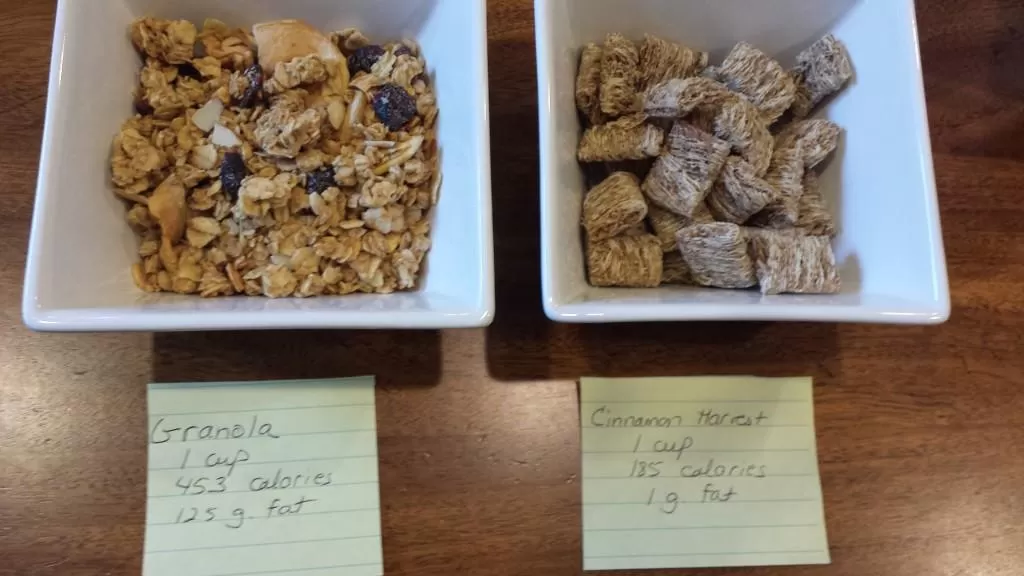Lowering Your Diet's Caloric Density: Eat More + Weigh Less
Published: 09/30/2018

SAME VOLUME OF FOOD Left: 1/2 cup low-fat ice cream and 1/2 cup berries = 164 calories Right: 1 cup regular ice cream = 400 calories
The ideal weight loss program satisfies hunger, reduces calories below what is needed and meets nutritional needs. What if you could eat the same or more, lose weight and not be hungry? If you choose the right foods, you can eat more for the same or fewer calories.
What Caloric Density Is and How It Can Help You Eat Less
Caloric density refers to the number of calories contained in a given volume or weight of food. It is typically measured in calories per gram (or per ounce) of food. Foods with high caloric density provide a large number of calories in a small volume or weight, while foods with low caloric density have fewer calories for the same amount of food.
In low-calorie-dense food, the calories are diluted by water and often fiber, so there are fewer calories in the same size bite. This is very helpful if you are trying to lose or maintain weight. Vegetables and fruits tend to be low in calorie density, so filling your plate with these foods can help you lose weight while minimizing feelings of hunger.
Cabbage provides 64 calories per pound and Oil provides 4000 calories per pound.
An example of food with high calorie density is ice cream. Its calories come from the caloric-dense sugar and the high-fat calorie-rich cream. A one-half cup or 100 grams of ice cream contains 260 calories. Foods like ice cream that are high in fat, typically are calorie-dense because fat has twice as many calories as either carbohydrates or fat. A gram of fat has 9 calories and a gram of fat or protein provides 4 calories. A high-fat diet promotes weight gain because it's high in calorie density.
One cup of butter has 1628 calories but one cup of spinach has 7 calories.
So, if you learn how to lower the overall caloric density of the foods you eat, you will feel full and satisfied. Lowering your diet's overall caloric density, as part of an integrated program of exercise and behavioral management, can result in significant weight loss that is sustained over time.
Research Shows That Eating Low Caloric Density Foods Is Beneficial for Weight Management and Overall Health
Here are a few studies that highlight the relationship between caloric density and eating less:
1. Volumetrics Study: The Volumetrics approach, developed by Barbara Rolls, emphasizes eating low-calorie-dense foods, such as fruits, vegetables, and broth-based soups. A study published in the American Journal of Clinical Nutrition found that participants who followed the Volumetrics eating plan consumed significantly fewer calories without feeling deprived.
2. Soup Study: In a study published in the journal Obesity, participants were given either a low-calorie soup or a high-calorie snack with the same caloric content before a meal. Those who consumed the soup consumed fewer total calories during the meal compared to those who ate the high-calorie snack, indicating that low-calorie foods can help reduce overall calorie intake.
3. Salad Study: Another study published in the journal Appetite investigated the effects of adding low-calorie salads to a meal. Participants who ate a salad with a lower caloric density before their main course consumed fewer calories during the meal compared to those who did not have a salad.
4. Energy Density Study: Research published in the Journal of the American Dietetic Association examined the impact of reducing the energy density of meals on calorie intake. Participants consumed meals with either high or low energy density but with the same weight. Those who ate the low-energy-density meals consumed fewer calories overall.
These studies collectively suggest that choosing foods with low caloric density, such as fruits, vegetables, whole grains, and lean proteins, can help you feel full while consuming fewer calories. Incorporating these foods into your diet can be an effective strategy for weight management and promoting overall health. If you focus your food choices around those you will naturally be eating a lower caloric density diet than if you focus your food choices around animal meat, processed starches. i.e., desserts, high fat foods, high fat meats, sugars, processed junk food, large volume oil nuts and oils.
Studies have shown that most people eat the same weight of food at meals; if that amount is lower in calories, you'll still feel full. Let's say you usually take 30 bites of food before feeling full. If you choose caloric-dense foods, those 30 bites will deliver a large amount of calories before you feel satisfied. If you choose low-calorie-dense foods, the same 40 bites will deliver fewer calories but the same sense of satisfaction. This lowers the calorie intake without reducing the weight of food you eat.
Suggestions On How To Lower Your Diet's Caloric Density

Portion size matters: 1 cup ice cream 360 calories & 20 grams fat versus 1/2 cup 180 calories and 10 grams
Here are some suggestions to get you started:
Fill half of your plate with fruits and vegetables to help you minimize your portions of foods higher in calorie density while still getting enough to eat so you feel full.
Add more vegetables to soups, stews, omelets, lasagna, chili and other main dishes to lower the energy density of the whole dish. Try using spiralized or shredded zucchini, spinach, diced green pepper, broccoli, chopped onion, diced carrots, diced mushrooms, tomatoes, and dark leafy greens.
Instead of having 1 cup of ice cream for dessert, have ½ cup of reduced-fat ice cream topped with ½ cup of fruit.
Use lower fat meat and cheese or use less of the higher fat ingredients.
Exchange crackers, pretzels, and chips with carrot sticks and bell pepper strips to serve with your favorite salsa, hummus or other dip.
Try having a big portion of a low-calorie salad, soup or fruit at the beginning of the meal.
Fill half your plate with vegetables and a small portion of carbohydrates and proteins.
Making a cheese appetizer tray? Instead of salami use prosciutto and add fruits like sliced pear, apples and grapes.
Take fruit and vegetables with you for snacks. This will help you avoid the temptation of turning to the vending machine for processed foods when you get hungry.
Choose lower fat protein. For instance, instead of a rib eye choose cod. Instead of bacon choose ham.
Use spiralized vegetables! This is the spiralizer tool I use to make my vegetable “noodles." I've tried many spiralizer tools and this one is a winner and an Amazon Choice!

Left cup contains 2 cups of cooked pasta = 400 calories. The other cup contains 2 cups of cooked spiralized zucchini = 60 calories
Take a look at the picture to see how you can use spiralized vegetables to lower the caloric density of your meals. One measuring cup contains 2 cups of cooked pasta that has 400 calories. The other cup contains 2 cups of cooked "zoodles" made of spiralized zucchini. This cup of zucchini has 60 calories. You can eat the whole 2 cup serving of either or what if you really wanted some pasta but want to reduce the caloric-density of your meals so you can eat more and feel full? Mix the two together as I did in the second photo. I mixed 1 cup of pasta with 1 cup of zucchini for a 260 calorie lunch instead of a 400 calorie lunch of all pasta. I also increased the nutrient content of my lunch. And it truly tasted delicious.
See what I mean? Vegetables and fruits tend to be low in energy density, so filling your plate with these foods can help you lose weight while minimizing feelings of hunger.
Decrease your portion of high caloric density foods. Portion size matters: 1 cup "regular" ice cream 360 calories and 20 grams fat 1/2 cup 180 calories and 10 grams
You can decrease your portion size or you can decrease the AMOUNT of calorie-dense fat food and INCREASE the low-caloric dense foods. If the half-cup portion of ice cream seems small, add some fresh raspberries. Another option would be to switch to reduced fat ice cream (Dryer's Churned) or do what I do, have a half cup portion of Dryer's Churned AND add the raspberries.
Decreasing the amount of calorie-dense fat will decrease the overall calories of your meal too. Limit the high-fat, calorically-dense condiments and foods that you eat and this will lower the overall calories that you eat. Instead of butter and sour cream on your potato, choose only one, or use low-fat sour cream or salsa. Instead of a cream sauce, order a tomato sauce based one. If you still want to enjoy butter on your bread once in a while, try using less. Switch from 2% milk to skim and you'll save 40 calories from the fat alone. Same volume of milk, fewer calories. And, yes, you will get used to the taste especially when you start enjoying your new thinner self.
More Ideas How to Lower Your Diet's Caloric Density

1 cup portion of each cereal. The granola on the left has 453 calories versus the Kashi Cinnamon Harvest which has 185. The granola is more calorically dense in part because it has more fat, 12.5 grams versus 1 gram in the Cinnamon Harvest.
The granola has 453 calories versus the Kashi Cinnamon Harvest which has 185. The granola is more calorically dense in part because it has more fat, 12.5 grams versus 1 gram in the Cinnamon Harvest.
To lower the calorie density of your diet, eat more foods that are high in water and/or fiber, including cooked grains, fruits, vegetables, and broth based soups. The water and fiber in vegetables, fruits and whole grains plays a crucial role in controlling hunger.
I also recommend seafood, fish, chicken breast, lean meats, and low-fat or nonfat dairy products are also on the menu. Because of its protein content, milk, even nonfat, helps people feel full and thus eat less. And choose whole-grain pasta, breads, and cereals; their fiber makes them more filling.
Fruits and vegetables are a good choice because not only do they have a low-caloric density, they are also nutrient-dense, which means they have a lot of nutrients per serving.
A nutrient-dense food provides a relatively high amount of healthy nutrients and a rather low amount of calories per gram. For example, one-half cup of strawberries weighs 152 grams and provides 49 calories. The strawberries provide only 0.3 calories per gram (49 calories/152 grams) of food, not to mention, 149% of the recommended daily value of vitamin-C and 3 grams of fiber!
When choosing fruits, opt for those that are fresh or frozen instead of fruit juices or dried fruit, which are higher in sugar and thus higher in calories per gram. Snack on grapes instead of raisins. A 100-calorie serving of raisins is only one-quarter cup; but a 100-calorie serving of grapes is nearly two cups. It's obvious which is going to make you feel fuller.
Calorie dense foods: High fat red meat, processed meats, fatty dairy products, and processed foods high in fat and sugar. Processed snack foods, candy, packaged snack foods, cakes, cookies and candies. Traditional fast foods such as cheeseburgers, fried chicken, and French fries and bakery items, prime rib, salami, cheesecake, butter, cheese, oils.
Nutrient-low-calorie-dense foods: Most fruits, non-starchy vegetables, air-popped popcorn, broth-based soups, fat-free dairy products, chicken, pork tenderloin, seafood, fish and beans. High fiber foods nonstarchy vegetables like broccoli, spinach, lettuce and carrots, are lower in energy density than starchy vegetables, like potatoes, peas and corn. Whole grains like oatmeal, air-popped popcorn, whole wheat and brown rice, and foods with lots of added water, such as soups. Lower fat foods, including pasta, noodles, breakfast cereals and yogurt, also tend to have a lower energy density.
You don't have to change your entire diet. By eating more meals and snacks that are lower in calorie density, you can still enjoy reasonable portions of your favorite calorie-dense foods while controlling calories. If you continue to eat the typical volume of food you eat, yet lower the calories in each portion, you'll consume fewer calories and feel just as full.
Sources
Bell EA, Castellanos VH, Pelkman CL, Thorwart ML, Rolls BJ. Energy density of foods affects energy intake in normal-weight women. Am. J. Clin. Nutr. 1998;67:412-420. [PubMed]
Bell EA, Rolls BJ. Energy density of foods affects energy intake across multiple levels of fat content in lean and obese women. Am. J. Clin. Nutr. 2001;73:1010-1018. [PubMed]
Catellier DJ, Hannan PJ, Murray DM, Addy CL, Conway TL, Yang S, et al. Imputation of missing data when measuring physical activity by accelerometry. Med. Sci. Sports. Exerc. 2005;37(Suppl, 11):S555-S562. [PMC free article] [PubMed]
Cox DN, Mela DJ. Determination of energy density of freely selected diets: methodological issues and implications. Int. J. Obes. Relat. Metab. Disord. 2000;24:49-54. [PubMed]
Drewnowski A. Energy density, palatability, and satiety: implications for weight control. Nutr. Rev. 1998;56:347-353. [PubMed]
Drewnowski A, Almiron-Roig E, Marmonier C, Lluch A. Dietary energy density and body weight: is there a relationship? Nutr. Rev. 2004;62:403-413. [PubMed]
Ello-Martin JA, Roe LS, Ledikwe JH, Beach AM, Rolls BJ. Dietary energy density in the treatment of obesity: a year-long trial comparing 2 weight-loss diets. Am. J. Clin. Nutr. 2007;85:1465-1477. [PMC free article] [PubMed]
Howarth NC, Murphy SP, Wilkens LR, Hankin JH, Kolonel LN. Dietary energy density is associated with overweight status among 5 ethnic groups in the multiethnic cohort study. J. Nutr. 2006;136:2243-2248. [PubMed]
Kant AK, Graubard BI. Energy density of diets reported by American adults: association with food group intake, nutrient intake, and body weight. Int. J. Obes. (Lond) 2005;29:950-956. [PubMed]
Kral TV, Rolls BJ. Energy density and portion size: their independent and combined effects on energy intake. Physiol. Behav. 2004;82:131-138. [PubMed]
Ledikwe JH, Blanck HM, Khan LK, Serdula MK, Seymour JD, Tohill BC, et al. Dietary energy density determined by eight calculation methods in a nationally representative United States population. J. Nutr. 2005;135:273-278. [PubMed]
Ledikwe JH, Blanck HM, Khan LK, Serdula MK, Seymour JD, Tohill BC, et al. Dietary energy density is associated with energy intake and weight status in US adults. Am. J. Clin. Nutr. 2006a;83:1362-1368. [PubMed]
Ledikwe JH, Blanck HM, Khan LK, Serdula MK, Seymour JD, Tohill BC, et al. Low-energy-density diets are associated with high diet quality in adults in the United States. J. Am. Diet. Assoc. 2006b;106:1172-1180. [PubMed]
Ledikwe JH, Rolls BJ, Smiciklas-Wright H, Mitchell DC, Ard JD, Champagne C, et al. Reductions in dietary energy density are associated with weight loss in overweight and obese participants in the PREMIER trial. Am. J. Clin. Nutr. 2007;85:1212-1221. [PubMed]
Marti-Henneberg C, Capdevila F, Arija V, Perez S, Cuco G, Vizmanos B, et al. Energy density of the diet, food volume and energy intake by age and sex in a healthy population. Eur. J. Clin. Nutr. 1999;53:421-428. [PubMed]
National Heart, Lung, and Blood Institute Clinical guidelines on the identification, evaluation, and treatment of overweight and obesity in adults: the evidence report. NIH Publication. 1998;98-4083 [PubMed]
Poppitt SD, Prentice AM. Energy density and its role in the control of food intake: evidence from metabolic and community studies. Appetite. 1996;26:153-174. [PubMed]
Rolls BJ, Barnett RA. The volumetrics weight-control plan: Feel full on fewer calories. HarperCollins Publishers; New York, NY: 2000.
Rolls BJ, Bell EA, Castellanos VH, Chow M, Pelkman CL, Thorwart ML. Energy density but not fat content of foods affected energy intake in lean and obese women. Am. J. Clin. Nutr. 1999;69:863-871. [PubMed]
Rolls BJ, Bell EA, Thorwart ML. Water incorporated into a food but not served with a food decreases energy intake in lean women. Am. J. Clin. Nutr. 1999;70:448-455. [PubMed]
Rolls BJ, Drewnowski A, Ledikwe JH. Changing the energy density of the diet as a strategy for weight management. J. Am. Diet. Assoc. 2005a;105:S98-S103. [PubMed]
Rolls BJ, Roe LS, Beach AM, Kris-Etherton PM. Provision of foods differing in energy density affects long-term weight loss. Obes. Res. 2005b;13:1052-1060. [PubMed]
Rolls BJ, Roe LS, Meengs JS. Reductions in portion size and energy density of foods are additive and lead to sustained decreases in energy intake. Am. J. Clin. Nutr. 2006;83:11-17. [PMC free article] [PubMed]
Stookey JD. Energy density, energy intake and weight status in a large free-living sample of Chinese adults: exploring the underlying roles of fat, protein, carbohydrate, fiber and water intakes. Eur. J. Clin. Nutr. 2001;55:349-359. [PubMed]
Westerterp-Plantenga MS. Effects of energy density of daily food intake on long-term energy intake. Physiol. Behav. 2004;81:765-771. [PubMed]
Young LR, Nestle M. The contribution of expanding portion sizes to the US obesity epidemic. Am J Public Health. 2002;92:246-249. [PMC free article] [PubMed]
Categories: Food Healthy Behavior Change Weight Management
Active Nutrition is a participant in the Amazon Associates Program, an affiliate advertising program designed to provide a way for websites to earn advertising revenues by advertising and linking to Amazon. If you click on one of my recommended item links and then place an order through Amazon, I receive a small commission on that sale, at no extra expense to you of course. This is a way to support me and my work every time you shop at no cost to you.






